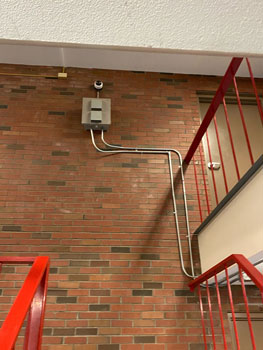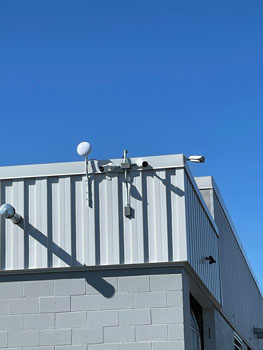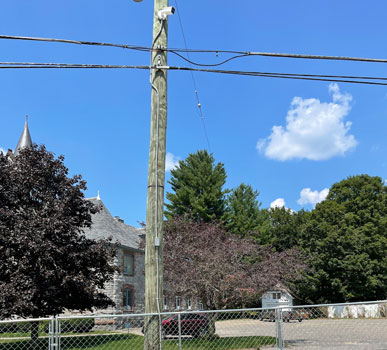Video MGMT System
 Access Control
Access Control
Voice & Data Wiring
 Burglar Alarm
Burglar Alarm
 Fire Alarm
Fire Alarm
Video MGMT System
Voice & Data Wiring
THOUGHT CENTER > Blog > Security Cameras
April 6, 2023
Dome and bullet cameras are two of the most commonly used commercial security cameras today. Both camera types provide surveillance coverage, but they're designed differently and meet different coverage needs. As you select cameras for your security installation, it's important to understand how their design affects their suitability for each area you need to monitor.
Bullet cameras are named for their form—which reminds some people of bullet casings and others of lipstick tubes. Their shape and relatively large size make them a good choice for deterrence.
Their relatively large size also allows for advanced features like optical zoom. Bullet cameras with optical zoom are able to capture both high-resolution, narrow views of distant subjects and high-resolution, wide-angle views of nearby subjects.
Dome cameras are named for the glass, dome-like housings around their camera components. These cameras are relatively small and don't look like cameras, which allows them to blend in with their surroundings.

Their small form necessitates wide-angle views and prevents long-range capabilities. There simply isn't enough internal space for the camera lens and image sensor to separate adequately for clear images of distant subjects.
Bullet cameras have a long, cylindrical shape that makes them hard to miss. Everyone can recognize their purpose instantly, making them excellent deterrence tools. The downside to their aggressive form is their tendency to make guests self-conscious or uncomfortable.

Dome cameras are the most discreet option for video surveillance. Their dome-shaped housings mask their camera components, making them ideal for upscale environments where security monitoring is necessary, but guests shouldn't feel like they're being surveilled.
Dome cameras have a wider viewing angle than bullet cameras, making them ideal for security in wide, large areas, such as ballrooms and banquet halls. However, they capture significantly clearer images of nearby subjects than of subjects from a longer range.
Bullet cameras, on the other hand, provide narrow but high-resolution footage of distant subjects. They're best suited for monitoring narrow points of interest, such as doorways, windows, and points of sale.
Some bullet cameras have fixed lenses that prevent zoom adjustments after installation, but many have optical zoom and pan-tilt-zoom (PTZ) capabilities. Bullet cameras with these features can be controlled remotely for easy adjustment even after installation.
Both dome and bullet cameras are more resistant to vandalism when installed in difficult-to-reach areas.
Unfortunately, criminals can violently shove bullet cameras to shift their field of view away from the areas they're supposed to surveil.
Dome cameras are more resistant to this form of vandalism because their protective housings prevent criminals from physically shifting their field of view.
In areas prone to repeated vandalism, "vandal-proof" dome camera models are a wise investment. These models have specialized housings designed to resist physical force. They're often rated IK10, the highest vandal-resistance rating possible for any security camera on the market.
Dome cameras are a popular choice for outdoor installations because their compact design makes them less attractive as foundations for spider webs and bird nests. In contrast, bullet cameras installed outdoors are vulnerable to such issues, which can require more maintenance effort.

All outdoor cameras should be weatherproof and selected for their ability to withstand the environmental conditions unique to the region where they are installed.
Ingress Protection (IP) ratings are an international grading standard that represents the ability of a camera model to resist damage from dust and moisture. The IP rating system is composed of two digits. The first digit indicates the level of protection against solid objects, and the second digit indicates protection against liquids. The solid protection ratings range from 0 (no protection) to 6 (complete protection against dust), while the liquid protection ratings range from 0 (no protection) to 9 (protection against powerful water jets).
For outdoor security cameras, a minimum IP rating of IP66 provides adequate protection against most dust, water, and snow events. Cameras with higher IP ratings are recommended for areas prone to hurricanes, tornadoes, or extreme winter storms.
In Connecticut and neighboring states, outdoor surveillance cameras should be selected for their operability on extremely cold days and nights. Cameras that operate at or below -40°F are equipped with thermal insulation and specialized heating mechanisms that prevent their internal components from freezing.
Whether indoors or outdoors, bullet cameras can be mounted flexibly—horizontally on ceilings, vertically on walls, and at any angle.
Indoor dome cameras have the same installation flexibility as bullet cameras, but outdoor dome cameras are another story. They should always be mounted in a flat, upside-down position, the base above the dome.
When an outdoor dome camera is mounted vertically or at an angle, water is likely to collect around its seal and crack the seal when freezing, leaving the internal camera components exposed to the elements.
Most dome and bullet cameras feature infrared LEDs to capture video footage at night and in low-light conditions.
However, bullet cameras are often preferred over dome cameras when reliable night vision surveillance is essential to security. This is because the protective glass that surrounds dome cameras can cause infrared (IR) bounce back at night, especially in outdoor installations, if changes in the weather warp the dome's anti-glare mechanism.
For the best nighttime security, bullet cameras equipped with special extended infrared (EXIR) capabilities are a wise investment. An EXIR camera has separate windows for its lens, and IR LED lights, a separation that results in the ability to surveil farther subjects in low-light conditions.
If you need a security camera that can act as a visual deterrent, a bullet camera is a smart choice. Their deterrence effect alone improves security, especially in high-crime areas. Bullet cameras also have a longer range than dome cameras, making them more useful for most surveillance needs.

Bullet cameras are commonly used for indoor surveillance at retail shops, gas stations, and commercial properties. Flexible outdoor installation options also make them an attractive solution for outdoor security. They can be mounted and tilted at any angle and on any solid surface, including outdoor poles.
Dome cameras are a great choice for monitoring wide areas like dining halls, ballrooms, and arenas, as well as areas where guests should not be reminded that they're being surveilled. Hotel lobbies, casinos, office buildings, upscale retail stores, and dine-in restaurants discreetly use dome cameras throughout their properties.

The added resistance to vandalism provided by dome housings also makes these cameras a smart choice for parking lots and areas where vandalism is likely.
If you are considering dome cameras, you might also be interested in our comparison of dome vs turret cameras.
NOT COMPLETELY SURE?
860-748-4292